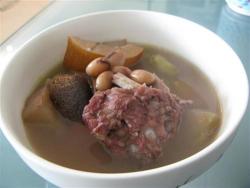Chinese Soup Ladies
With their blog TheChineseSoupLady.com, the Tong sisters are showing the health benefits of Chinese soups through the internet, one recipe at a time.
While growing up in Toronto, Tracy and Lisa Tong rarely wanted to drink the Chinese soups that their mother served with dinner. The broths, filled with Chinese vegetables and herbs, just didn’t appeal to the two Chinese Canadian kids.
But now, the sisters – whose family name, Tong (湯) literally means soup in Cantonese – have been on a two year journey since starting their blog TheChineseSoupLady.com, learning the ins and outs of making Chinese soups, and showing people how they can help one’s health.
“When we were younger, I’d look at the soups my mom made and ask, ‘What’s that? What’s that?’, not wanting to drink it,” Lisa (pictured left), an IT strategist, says.
“Chinese style soups, in general, are really healthy. They’re made with lean protein, vegetables and herbs to help treat symptoms."
“It’s a comfort food though and there are health benefits that our parents wanted to pass off to their children. I definitely see that, as I’ve gotten older, I have the same mentality.”
Now based in Hong Kong, both Lisa and Tracy (pictured right) found they craved Chinese soups when they moved out on their own, and became more interested in making them. This interest soon turned into a documented journey on TheChineseSoupLady.com, where the Tong sisters have so far posted 202 traditional Cantonese soup recipes and ingredients they have made and experimented with.
“Chinese style soups, in general, are really healthy,” says Tracy, who works in marketing and communications. “They’re made with lean protein, vegetables and herbs to help treat symptoms. Drinking something warm is good for winter, and if you have a soup every day, it can’t be a bad thing.”
The website also has a comprehensive index explaining their ingredients’ health benefits, precautions and what’s ‘heaty’ and ‘cooling’ so visitors can figure out which soups suit their health situation best.
For example, the website explains how some ‘cooling’ ingredients, such as watercress, help balance bodies by relieving ‘heaty’ symptoms such as cold sores and a rough, dry tongue, while also warning that gingko biloba should not be consumed by pregnant women, or people allergic to poison ivy or mangoes.
“You might know the herbs, but maybe not how they help you. The point is to fill in question marks about what you’re drinking. It’s been helpful in that it’s filled in the gap between what we saw when were little, and what we know now,” Lisa says.
The recipes are derived from a few different sources, including local Hong Kong herbalists, meat or vegetable market vendors, and of course, their own Tong family recipes that have been passed down.
“It’s really amazing. Hong Kong has a lot of general knowledge out there. All you have to do is ask people, and they’ll tell you, ‘add this, add that’,” Tracy says.
And there is definitely an appetite for Chinese soups. Since launching the website in 2008, TheChineseSoupLady.com now sees about 40,000 page views per month, mostly from China, Hong Kong and Europe.
“I’ve developed a greater appreciation for Chinese soups. I thought they were very simple, but they’re actually quite complex,” Tracy adds. “I don’t know if my taste has changed, or because I know they’re healthy, but I really enjoy them now.”
Old Cucumber Soup with Azuki Beans and Lentils
Traditional Chinese Name: 老黄瓜赤小豆扁豆汤 (lao huáng gua- chì xiao dòu bian dòu tang)
Old cucumber soup is a Chinese classic that’s ideal for the wet and stuffy spring season. It helps eliminate body moisture and heat, and has a diuretic effect on the body. The lentils and beans are great consumption protein for children and they're healthy for the whole family.
 Ingredients:
Ingredients:
• 1 medium-sized old cucumber
• 1 pound of fresh pork bones
• 80g of azuki beans
• 80g of lentils
• 3-4 large dried dates
• 1 piece of dried tangerine peel
• 2-3L of water
• 1-2 teaspoons of salt
Preparation:
1. Pre-marinate the pork with the salt and let it sit for at least an hour (overnight is best)
2. Rinse and then soak the azuki beans, lentil and tangerine peel for at least 30 minutes
3. Begin boiling your soup water
4. Blanch the pork in a separate pot of boiling water
5. Wash tangerine peel while scraping off seed pouches with a small knife
6. Wash and peel old cucumber. Keep the skin and remove the seed pouch. Cut into large cubes
7. Bring water to a boil and put all the ingredients in together. Bring to boil
8. Reduce to low heat and simmer for three hours. Serve and enjoy!
For more on this soup’s health benefits, and additional Chinese soup recipes, check out www.thechinesesouplady.com

